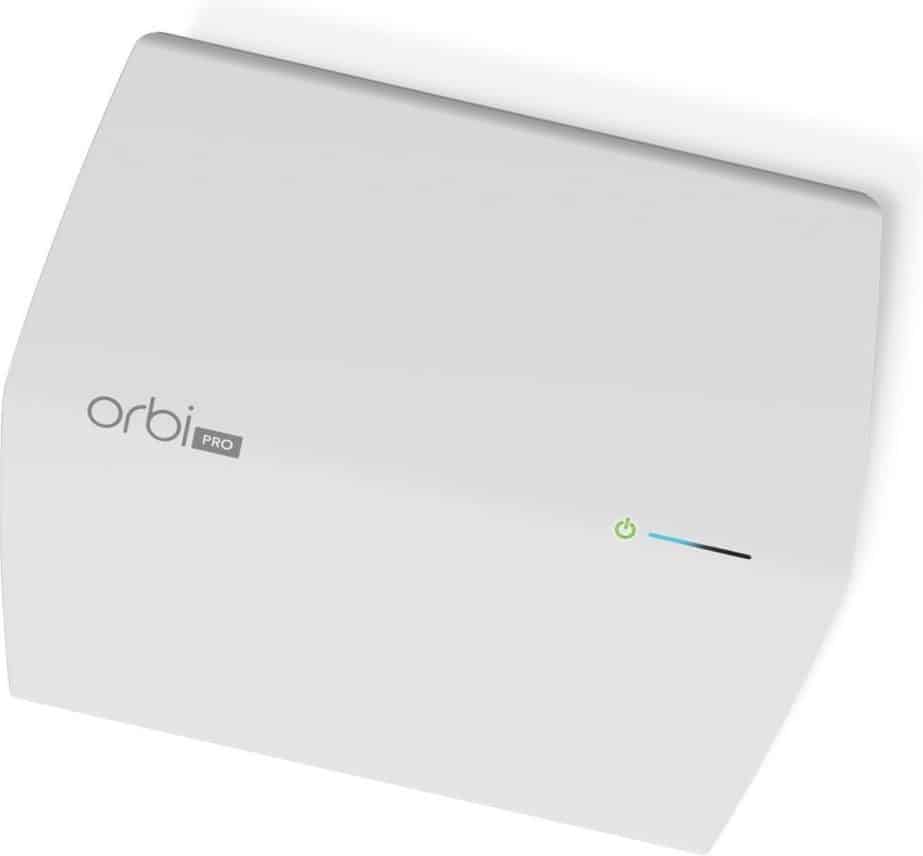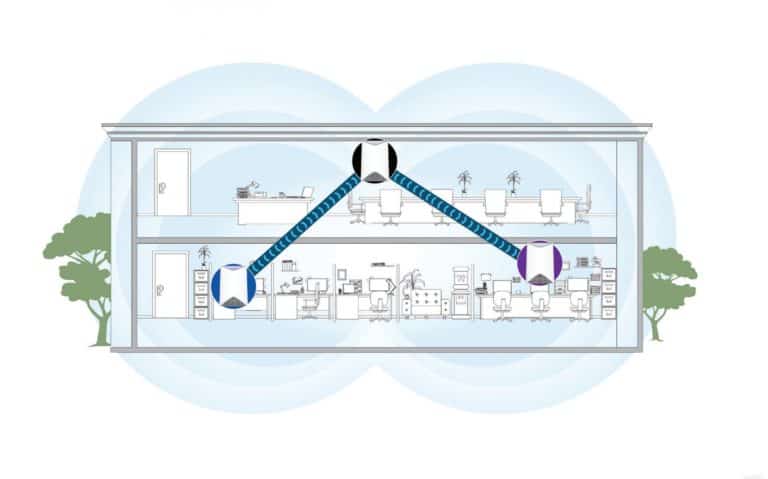Netgear asked us if we could shed some light on the new Netgear Orbi Pro products. These products allow you to easily set up a wireless network with different access points, eliminating the need for network cables. This brings us to the most important question: is it possible to work without network cables in a business environment?
First, let’s return to the NetGear Orbi Products. The product name is clearly not a new addition. We already wrote a review about the consumer version of NetGear Orbi at the beginning of 2017 for our parent site in the Netherlands. Later that year we wrote a review about the NetGear Orbi Pro. At the time, it wasn’t all good, we did have some feedback for NetGear. Although the products worked well, they were presented as mesh products while theoretically, they were not. The different access points only worked in a star topology, which means that a satellite (access point) only worked if it was in a direct connection with the router. A satellite could not yet connect to the router through another satellite. That is the theory behind mesh. In the end, it took quite a long time to solve this problem and make Orbi Pro work as intended. We don’t intend on bringing up past mistakes, because this technology is incredibly complex. It is especially challenging to develop the firmware flawlessly. But in the end, NetGear managed to do just that.
In which situation does the Netgear Orbi Pro fit well?
The main competitor of Netgear Orbi Pro is the familiar access point, also part of Netgear’s own portfolio. In an office where teams work with more than ten people, there’s often a need for multiple set-up points for the wireless network. In a standard office building with network cables everywhere, the purchase of access points is the easiest solution.
However, there are many situations where you need multiple set-up points because you need to cover a larger space or network cables are not available or a real option. Those situations require creative solutions, and Netgear’s Orbi Pro is just that. Imagine a company building with a large open space, a large shop, an office in a historic building or you’re organising events at different locations. These spaces don’t have the standard infrastructure with network cables. These locations are where Orbi Pro excels.
How does the Netgear Orbi Pro work?
Usually, regular access points are connected using a network cable, but this is optional with the Orbi Pro. The access points, Netgear calls them satellites, connect to each other wirelessly. What Netgear has done is to provide the satellites with antennas for both the 2.4 GHz and 5 GHz band so all endpoints can connect and have a fast connection. There are also additional 5GHz antennas that are dedicated for traffic between satellites or between the satellite and the Orbi Pro router. This way it’s possible to build a network over a long distance with a big coverage without the need for network cables. You only need several power sockets.

For this test, Netgear asked us to test the Orbi Pro Ceiling Satellite (SRC60). This is a ceiling model with a different design than the regular satellites, but it can cover a much larger area (up to 230 m2 / 2500 sq feet). A standard satellite can cover an area of about 175 m2 (2000 sq feet). All units have three bands to connect to, resulting in a maximum speed of about 3000 Mbps (1773+866+400). However, this is more a theoretical speed, it is not something you can get in real-world. In our real-world test on a network with more than 40 devices connected to it, divided over 4 satellites, we reached about 150 to 250 Mbit/s depending on the distance and walls between the endpoint and the satellite. This speed is more than sufficient for every business application.
Combination of usability and the technical world
In the end, Netgear tries to combine two worlds that are difficult to bring together. On one hand, a very complex network infrastructure, and on the other hand, usability, everyone should be able to install and use Orbi. The product needs to have a good user experience, but above all, it has to be simple. Everyone should be able to buy, unpack and install these products. Netgear developed an app (available for iOS and Android) which guides you through the installation and basic configuration.
Over the past six months, we installed the system several times, because the first time we installed the new products things did not go flawlessly. We couldn’t get it to work through the app and eventually had to configure the network through the web interface. This was not particularly complicated, but it is an extra step that is certainly not for everyone.
Another reason to revise the configuration was the connection problems we experienced in the first couple of weeks. Endpoints on the network spontaneously dropped out or were no longer available. Some satellites could not find the router somehow. Although star topology works best, we also looked at how the network operates with an extra satellite in between. This was not recommended for the first few weeks in terms of performance. Nowadays, these problems don’t affect Netgear anymore.

Occasionally we get the idea that Netgear might put a little too much pressure on its staff to release products to the market. We’ve noticed it before with the earlier Orbi versions, and this time it’s no different. During the first few months, a lot of small problems have to be fixed, the first firmware versions are just not good enough. Six months later we can honestly conclude that we haven’t experienced a single problem in the network in 2020. Make no mistake, we still test it daily, and every few weeks we tweak the settings and change the setup to find out just how stable the setup is and whether we can improve the network.
We suspect that the new design of the Ceiling unit may have presented additional challenges with the algorithms that send out the signals. Netgear probably needed to adjust those to the new design. The other units still have the same design as before and didn’t have any problems.
In recent months, we noticed that both the installation and overall performance have improved with each firmware version. In the beginning, the Orbi’s were also configured on a very crowded channel, where they struggled to get the signal across properly. Nowadays, during the installation of Orbi Pro a scan takes place that chooses a channel that isn’t crowded.
A user without any technical knowledge is now able to install Orbi Pro without any problem, which means NetGear did accomplish their goal. To be honest, it’s never perfect, there are always things to optimise manually. Finetuning a network takes time, something NetGear should try to automate in the future even further. Currently, NetGear only inspects the channels during the installation, but it would be a good thing to scan the channels more often. When you decide to go for Orbi Pro, using an installation company is still advisable in a complex business environment.
Is Orbi Pro suitable for me?
We obviously thought about what kind of buildings or situations Orbi Pro would be most suitable for. If you don’t want or can have any network cabling, Orbi Pro is the solution for you. An installation that would typically take a day can now be done in under an hour. An Orbi Pro-network can be expanded to 8 units, an Orbi Pro router with a maximum of 7 satellites. That is an area of 8×230 m2 (20.000 sq feet) or 8×175 m2 (16.000 sq feet). Not many companies need to cover such a large area.
Orbi Pro is also suitable for events. All you need is a power outlet. Once the satellites are configured, they will find each other to create a large mesh network. In the end, Orbi Pro’s biggest strength is usability and simplicity.
Business features
The Orbi Pro has all the business features that SMBs require. You can transmit and separate up to three wireless networks, for example, a network for PCs and smartphones and another network for industrial machines. It’s also useful for public guest networks, think of a reception area or meeting space. such as a showroom of a car company where many customers come to visit. You can also create a captive portal where customers first have to agree to the terms and conditions and where the latest deals can be displayed.
All in all Netgear Orbi Pro is an easy and straightforward solution for a professional wireless network with excellent performance. It’s also really affordable. The price is approximately the same as traditional access points. You can acquire an Orbi Pro Router with satellite for 369 euros. One router with four satellites will cost you just under 1000 euros.


